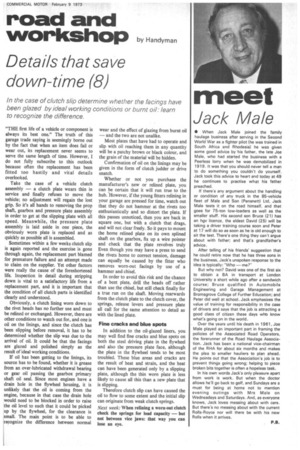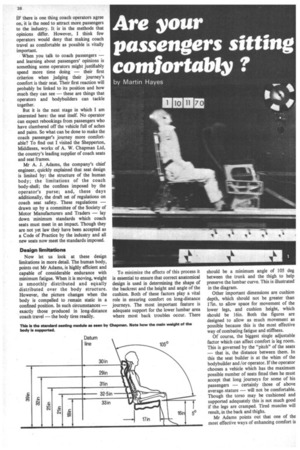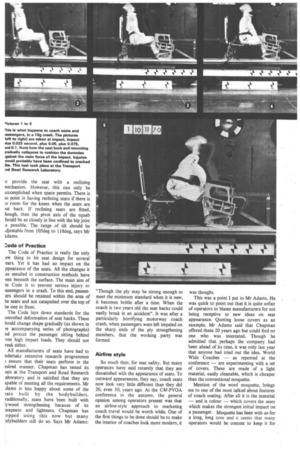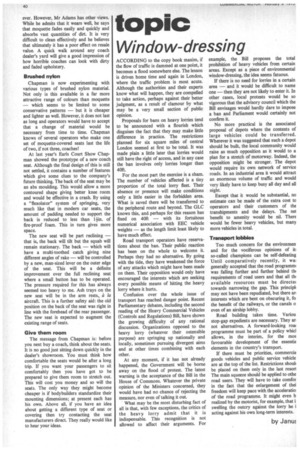meet
Page 39

Page 40

Page 41

Page 42

If you've noticed an error in this article please click here to report it so we can fix it.
Jack Male
• When Jack Male joined the family haulage business after serving in the Second World War as a fighter pilot (he was trained in South Africa and Rhodesia) he was given some good advice by his father, the late Joe Male, who had started the business with a Peerless lorry when he was demobilized in 1919. It was that you should never tell a man to do something you couldn't do yourself. Jack took this advice to heart arid today at 49 he continues to practise what his father preached.
If there's any argument about the handling or condition of any truck in the 85-vehicle fleet of Male and Son (Pensnett) Ltd, Jack Male tests it on the road himself, and that goes for 75-ton low-loaders as well as the smaller stuff. His second son Bruce (21) has an hgv licence, the eldest David (25) will be taking a driver training course soon and Peter at 17 will do so as soon as he is old enough to sit the test. There's one thing they can't argue about with father; and that's grandfather's advice.
After telling of his friends' suggestion that he could retire now that he has three sons in the business, Jack's unspoken response to the idea is typically: "Who — me?"
But why not? David was one of the first six to obtain a BA in transport at London University a short while ago after a sandwich course; Bruce qualified in Automobile Engineering and Garage Management at Bromsgrove College of Further Education; and Peter did well at school. Jack emphasizes the value of training for responsibility in the case of drivers and says that the job is attracting a good class of citizen these days whb know what's going on in the world.
Over the years until his death in 1961, Joe Male played an important part in framing the policies of the Associated Road Operators, the forerunner of the Road Haulage Association. Jack has been a national vice-chairman of the RHA for about six months and makes the plea to smaller hauliers to plan ahead. He points out that the Association's job is to prevent things going wrong; helping to piece broken bits together is often a hopeless task.
In his own words Jack's only pleasure apart from work is work. But when the doctor allows he'll go back to golf, and Sundays are a must for being at home not to mention evening outings with Mrs Male on Wednesdays and Saturdays. And, as everyone knows, Jack loves messing about with cars. But there's no messing about with the current Rolls-Royce nor will there be with his new Rolls when it arrives.
IF there is one thing coach operators agree on, it is the need to attract more passengers to the industry. It is in the methods that opinions differ. However, I think few operators would deny that making coach travel as comfortable as possible is vitally important.
When you talk to coach passengers — and learning about passengers' opinions is something some operators might justifiably spend more time doing — their first criterion when judging their journey's comfort is their seat. Their first reaction will probably be linked to its position and how much they can see these are things that operators and bodybuilders can tackle together.
But it is the next stage in which I am interested here: the seat itself. No operator can expect rebookings from passengers who have clambered off the vehicle full of aches and pains. So what can be done to make the coach passenger's journey more comfortable? To find out I visited the Shepperton, Middlesex, works of A. W. Chapman Ltd, the country's leading supplier of coach seats and seat frames.
Mr A. J. Adams, the company's chief engineer, quickly explained that seat design is limited by: the structure of the human body; the limitations of the coach body-shell; the confines imposed by the operator's purse; and, these days additionally, the draft set of regulations on coach seat safety. These regulations — drawn up by a committee of the Society of Motor Manufacturers and Traders — lay down minimum standards which coach seats must meet in an impact. Though they are not yet law they have been accepted as a Code of Practice by the industry and all new seats now meet the standards imposed.
Design limitations Now let us look at these design limitations in more detail. The human body, points out Mr Adams, is highly efficient and capable of considerable endurance with minimum fatigue. When it is moving, weight is smoothly distributed and equally distributed over the body structure. However, the picture changes when the body is compelled to remain static in a confined position. In such circumstances — exactly those produced in long-distance coach travel — the body tires readily. To minimize the effects of this process it is essential to ensure that correct anatomical design is used in determining the shape of the backrest and the height and angle of the cushion. Both of these factors play a vital role in ensuring comfort on long-distance journeys. The most important feature is adequate support for the lower lumbar area where most back troubles occur. There
should be a minimum angle of 105 deg between the trunk and the thigh to help preserve the lumbar curve. This is illustrated in the diagram.
Other important dimensions are cushion depth, which should not be greater than 17in. to allow space for movement of the lower legs, and cushion height, which should be 16in. Both the figures are designed to allow as much movement as possible because this is the most effective way of combating fatigue and stiffness.
Of course, the biggest single adjustable factor which can affect comfort is leg room. This is governed by the "pitch" of the seats — that is, the distance between them. In this the seat builder is at the whim of the bodybuilder and /or operator. If the operator chooses a vehicle which has the maximum possible number of seats fitted then he must accept that long journeys for some of his passengers -certainly those of above average-stature — will not be comfortable. Though the torso may be cushioned and supported adequately this is not much good if the legs are cramped. Tired muscles will result, in the back and thighs.
Mr Adams points out that one of the most effective ways of enhancing comfort is o provide the seat with a reclining nechanism. However, this can only be iccomplished when space permits. There is to point in having reclining seats if there is o room for the knees when the seats are iut back. If reclining seats are fitted, hough, then the pivot axis of the squab hould be as closely in line with the hip joint .s possible. The range of tilt should be .djustable from 105deg to 118deg, says Mr dams.
ode :ode of Practice The Code of Practice is really the only ew thing to hit seat design for several ears. Yet it has had no impact on the ppearance of the seats. All the changes it as entailed in construction methods have een beneath the surface. The main aim of le Code is to prevent serious injury to lassengers in a crash. To this end, passeners should be retained within the area of he seats and not catapulted over the top of he one in front.
The Code lays down standards for the ontrolled deformation of seat backs. These hould change shape gradually (as shown in le accompanying series of photographs) nd protect the passenger sitting behind .om high impact loads. They should not reak either.
All manufacturers of seats have had to ndertake extensive research programmes ) ensure that their seats perform in the esired manner. Chapman has tested its :ats at the Transport and Road Research aboratory and is satisfied that they are Table of meeting all the requirements. Mr .dams is less happy about some of the :ats built by the bodybuilders. raditionally, seats have been built with [ywood strengthening because of its leanness and lightness. Chapman has .opped using this now but many xlybuilders still do so. Says Mr Adams: "Though the ply may be strong enough to meet the minimum standard when it is new, it becomes brittle after a time. When the coach is two years old the seat backs could easily break in an accident". It was after a particularly horrifying motorway coach crash, when passengers were left impaled on the sharp ends of the ply strengthening ' members, that the working party was formed.
Airline style So much then, for seat safety. But many operators have said recently that they are dissatisfied with the appearance of seats. To outward appearances, they say, coach seats now look very little different than they did 20, even 30, years ago. At the CM-PVOA conference in the autumn, the general opinion among operators present was that an airline-style approach to marketing coach travel would be worth while. One of the first things to be done should be to make the interior of coaches look more modern, it was thought.
This was a point I put to Mr Adams. He was quick to point out that it is quite unfair of operators to blame manufacturers for not being receptive to new ideas on seat appearance. Quoting loose covers as an example, Mr Adams said that Chapman offered these 20 years ago but could find no one who was interested. Though he admitted that perhaps the company had been ahead of its time, it was only last year that anyone had tried out the idea. World Wide Coaches — as reported at the conference — are experimenting with a set of covers. These are made of a light material, easily cleanable, which is cheaper than the conventional moquette.
Mention of the word moquette, brings me to one of the most talked about features of coach seating. After all it is the material — and is colour — which covers the seats which makes the strongest initial impact on a passenger. Moquette has been with us for a long, long time and it seems that many operators would be content to keep it for ever. However, Mr Adams has other views. While he admits that it wears well, he says that moquette fades easily and quickly and absorbs vast quantities of dirt. It is very difficult to clean effectively and he believes that ultimately it has a poor effect on resale value. A quick walk around any coach dealer's yard will give a good impression of how horrible coaches can look with dirty and faded upholstery.
Brushed nylon Chapman is now experimenting with various types of brushed nylon material. Not only is this available in a far more attractive range of colours than moquette — which seems to be limited to some conservative patterns — but it is cheaper and lighter as well. However, it does not last as long and operators would have to accept that a change of material would be necessary from time to time. Chapman knows of several operators who make one set of moquette-covered seats last the life of two, if not three, coaches!
At last year's Earls Court Show Chapman showed the prototype of a new coach seat. Although the final design of this is still not settled, it contains a number of features which give some clues to the company's future thinking. The back of the seat may be an abs moulding. This would allow a more contoured shape giving better knee room and would be effective in a crash. By using a "flexolator" system of springing, very much like that in modern car seats, the amount of padding needed to support the back is reduced to less than lfin. of fire-proof foam. This in turn gives more space.
The new seat will be part reclining — that is, the back will tilt but the squab will remain stationary. The back — which will have a multi-toothed catch giving nine different angles of rake — will be controlled by a new, man-sized lever on the outer edge of the seat. This will be a definite improvement over the full reclining seat where a small button has to be operated. The pressure required for this has always seemed too heavy to me. Ash trays on the new seat will be in the arm rests, a la aircraft. This is a further safety aid: the old position on the back of the seat was right in line with the forehead of the rear passenger. The new seat is expected to augment the existing range of seats.
Give them room The message from Chapman is: before you next buy a coach, think about the seats. It is no good just sitting down quickly in the dealer's showroom. You must think how comfortable the seats would be after a long trip. If you want your passengers to sit comfortably then you have got to be prepared to give them room to stretch out. This will cost you money and so will the seats. The only way they might become cheaper is if bodybuilders standardize their mounting dimensions; at present each has his own. Above all, if you have an idea about getting a different type of seat or covering then try contacting the seat manufacturers direct. They really would like to hear your ideas.
































































































